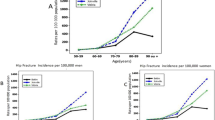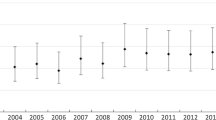Abstract
Introduction
Osteoporosis is a very common disease, and data on its epidemiology is important for health care strategy implementation. Brazil is a developing country; its population is aging, leading to an expected increase in hip fractures and their undesirable consequences.
Objective
Assess the incidence of osteoporotic hip fractures and subsequent mortality in Southern Brazil as part of a large epidemiological study aiming to reinforce the data for FRAX Brazil.
Study design
This study evaluated all admissions for fragility hip fractures between April 1, 2010, and March 31, 2012, in the city of Joinville, including both genders of patients 50 years old or older, which corresponded to 19.2% of the local population. Joinville was chosen because it is the third largest city in the south of Brazil, with a representative population predominantly composed of descendants of European immigrants.
Results
There were 213 cases of hip fractures, predominantly in Caucasians (n = 204, 96.7%) whose mean age was 77.7, ± 10.5, of which 143 (67.1%) were women (79.5 ± 9.6 years) and 70 (32.9%) were men (74 ± 11.3 years). The annual incidence of hip fractures was 268.8 for women and 153.0 for men/100,000 inhabitants. In the 60 to 64-year group, the overall incidence was 92.1/100,000, with an age-related increase of 1410.1/100,000 in the 80 to 84-year group. The mortality rate during hospitalization was 7.5%, and 25% died during the 12 months following their fractures.
Conclusion
The incidence of hip fractures among the oldest in this predominantly Caucasian population living in Southern Brazil was similar to that of European populations from the northern hemisphere. The annual incidence of fragility hip fractures among people in their 80s was 59 times higher than that among people in their 50s. The mortality rate was 4.3 times higher in the first year after hip fracture than in the age-related local population.


Similar content being viewed by others
References
Kanis JA, Oden A, Mccloskey EV, Johansson H, Wahl DA, Cooper C (2012) A systematic review of hip fracture incidence and probability of fracture worldwide. Osteoporos Int 23(9):2239–2256
Gerland P, Raftery AE, Sevcikova H, Li N, Gu D, Spoorenberg T et al (2014) World population stabilization unlikely this century. Science 346(6206):234–237
Cooper C, Campion G, Melton LJ (1992) Hip fractures in the elderly: a worldwide projection. Osteoporos Int 2:285–289
Schemitsch E, Bhandari M (2009) Femoral neck fractures: controversies and evidence. J Orthop Trauma 23(6):385
Schwartz AV, Kelsey JL, Maggi S, Tuttleman M, Ho SC, Jónsson PV et al (1999) International variation in the incidence of hip fractures: cross-national project on osteoporosis for the World Health Organization Program for Research on Aging. Osteoporos Int 9(3):242–253
Gallagher JC, Melton LJ, Riggs BL, Bergstralh E (1980) Epidemiology of fractures of the proximal femur in Rochester, Minnesota. Clin Orthop 150:163–171
Lofthus CM, Osnes EK, Falch JA, Kaastad TS, Kristiansen IS, Nordsletten L, Stensvold I, Meyer HE (2001) Epidemiology of hip fractures in Oslo, Norway. Bone 29(5):413–418
Bacon WE, Maggi S, Looker A, Harris T, Nair CR, Giaconi J et al (1996) International comparison of hip fracture rates in 1988–89. Osteoporos Int 6:69–75
Frandsen PA, Kruse T (1983) Hip fractures in the county of Funen, Denmark: implications of demographic aging and changes in incidence rates. Acta Orthop 54(5):681–686
Kanis JA, Johnell O, Oden A, Johansson H, Mccloskey E (2008) FRAX™ and the assessment of fracture probability in men and women from the UK. Osteoporos Int 19:385–397
Johnell O, Gullberg B, Allander E, Kanis JA (1992) The apparent incidence of hip fracture in Europe: a study of national register sources. MEDOS study group. Osteoporos Int 2:298–302
Nydegger V, Rizzoli R, Rapin CH, Vasey H, Bonjour JP (1991) Epidemiology of fractures of the proximal femur in Geneva: incidence, clinical and social aspects. Osteoporos Int 2(1):42–47
Baudoin C, Fardellone P, Potard V, Sebert JL (1993) Fractures of the proximal femur in Picardy, France, 1987. Osteoporos Int 3(1):43–49
Ho SC, Bacon WE, Harris T, Looker A, Maggi S (1993) Hip fracture rates in Hong Kong and the United States, 1988 through 1989. Am J Public Health 83:694–697
Bagur A, Mautalen C, Rubin Z (1994) Epidemiology of hip fractures in an urban population of Central Argentina. Osteoporos Int 4:332–335
Xu L, Lu A, Zhao X, Chen X, Cummings SR (1996) Very low rates of hip fracture in Beijing, People’s Republic of China: the Beijing osteoporosis project. Am J Epidemiol 144:901–907
Caniggia M, Morreale P (1989) Epidemiology of hip fractures in Siena, Italy, 1975-1985. Clin Orthop Relat Res 238:131–138
Morales-Torres J, Gutiérrez-Ureña S (2004) Osteoporosis Committee of Pan-American League of Associations for Rheumatology. The burden of osteoporosis in Latin America. Osteoporos Int 15(8):625–632
Castro DA, Rocha FA, Ribeiro AR (2003) Low incidence of hip fractures in an equatorial area. Osteoporos Int 14(6):496–499
Silveira VA, Medeiros MM, Coelho-Filho JM, Mota RS, Noleto JC, Costa FS et al (2005) Hip fracture incidence in an urban area in Northeast Brazil. Cad Saude Publica 21(3):907–912
Komatsu RS, Ramos LR, Szejnfeld VL (2004) Incidence of proximal femur fractures in Marilia, Brazil. J Nutr Health Aging 8(5):362–367
Kanis JA (2008) On behalf of the WHO scientific group. Assessment of osteoporosis at the primary health-care level. Technical report. WHO Collaborating Centre, University of Sheffield, UK, Sheffield http://www.shef.ac.uk/FRAX
Zerbini CAF, Szejnfeld VL, Albergaria BH, Mccloskey EV, Johansson H, Kanis JA (2003) Incidence of hip fracture in Brazil and the development of an FRAX model. Arch Osteoporos 10:28–34
IBGE [Internet]. Censo Demográfico 2010: características da população e dos domicílios: resultados do universo. Available in: http://www.ibge.gov.br/home/estatistica/populacao/censo2010/default.shtm. Accessed 07 April 2019
Nazrun AS, Tzar MN, Mokhtar SA, Mohamed IN (2014) A systematic review of the outcomes of osteoporotic fracture patients after hospital discharge: morbidity, subsequent fractures, and mortality. Ther Clin Risk Manag 10:937–948
Melton J (1993) Hip fractures: a worldwide problem today and tomorrow. Bone 14:S1–S8
Rosengren BE, Karlsson MK (2014) The annual number of hip fractures in Sweden will double from year 2002 to 2050: projections based on local and nationwide data. Acta Orthop 85:234–237
Siqueira FV, Facchini LA, Hallal PC (2005) The burden of fractures in Brazil: a population-based study. Bone 37(2):261–266
Lin KB, Yang NP, Lee YH, Chan CL, Wu CH, Chen HC et al (2018) The incidence and factors of hip fractures and subsequent morbidity in Taiwan: an 11-year population-based cohort study. PLoS One 13(2):e0192388
Contreras L, Kirschbaum A, Pumarino H (1991) Epidemiology of fractures in Chile. Rev Med Chil 119(1):92–98
Johansson H, Clark P, Carlos F, Oden A, Mccloskey EV, Janis JA (2011) Increasing age- and sex-specific rates of hip fracture in Mexico: a survey of the Mexican Institute of Social security. Osteoporos Int 22:2359–2364
Silva DMW, Vitti A, Otero MSS, Damas TB, Ghanem O, Gonçalves ARR (2014) Prevalência de Deficiência de Vitamina D em Joinville-SC. Arq Bras Endocrinol Metabol 58:5347
Leboff MS, Kohlmeier L, Hurwitz S, Franklin J, Wright J, Glowacki J (1999) Occult vitamin D deficiency in postmenopausal US women with acute hip fracture. JAMA 281(16):1505–1511
Simonelli C, Weiss TW, Morency J, Swanson L, Chen YT (2005) Prevalence of vitamin D inadequacy in a minimal trauma fracture population. Curr Med Res Opin 21(7):1069–1074
Pasco JA, Henry MJ, Kotowicz MA, Sanders KM, Seeman E, Pasco JR, Schneider RG, Nicholson GC (2004) Seasonal periodicity of serum vitamin D and parathyroid hormone, bone resorption, and fractures: the Geelong osteoporosis study. J Bone Miner Res 19(5):752–758
Johnell O, Kanis JA, Odén A et al (2004) Fracture risk following an osteoporotic fracture. Osteoporos Int 15(3):175–179
Cooper C, Atkinson EJ, Jacobsen SJ et al (1993) Population-based study of survival after osteoporotic fracture. Am J Epidemiol 137:1001–1005
Fortes EM, Raffaelli MP, Bracco OL, Takata ETT, Reis FB, Santilli C, Lazaretti-Castro M (2008) Elevada morbimortalidade e reduzida taxa de diagnóstico de osteoporose em idosos com fratura de fêmur proximal na cidade de São Paulo. Arq Bras Endocrinol Metabol 52:1106–1114
Vidal EI, Coeli CM, Pinheiro RS, Camargo KR Jr (2006) Mortality within 1 year after hip fracture surgical repair in the elderly according to postoperative period: a probabilistic record linkage study in Brazil. Osteoporos Int 17(10):1569–1576
Majumdar SR, Kim N, Colman I et al (2005) Incidental vertebral fractures discovered with chest radiography in the emergency department: prevalence, recognition, and osteoporosis management in a cohort of elderly patients. Arch Intern Med 165(8):905–909
Roberts SE, Goldacre MJ (2003) Time trends and demography of mortality after fractured neck of femur in an English population, 1968-98 database study. BMJ. 327:771–776
Garcia R, Leme MD, Garcez-Leme LE (2006) Evolution of Brazilian elderly with hip fracture secondary to a fall. Clinics 61(6):539–544
Dorner T, Weichselbaum E, Lawrence K, Viktoria SK, Rieder A (2009) Austrian osteoporosis report: epidemiology, lifestyle factors, public health strategies. Wien Med Wochenschr 159:221–229
Pinheiro MM, Ciconelli RM, Martini LA, Ferraz MB (2009) Clinical risk factors for osteoporotic fractures in Brazilian women and men: the BRAZilian Osteoporosis Study (BRAZOS). Osteoporos Int 20(3):399–408
Acknowledgments
We acknowledge the work of the Document Sector employees of the Hospital Municipal São José, Centro Hospitalar Unimed and Hospital Dona Helena, in Joinville, SC. We further cordially thank Ms. Mercedes Terezinha Weber Silva for her support in telephone interviews with patients and Ms. Marcia Olandoski for her statistical work.
Author information
Authors and Affiliations
Author notes
Sergio Ragi Eis is deceased. This paper is dedicated to his memory.
- Sergio Ragi Eis
Corresponding author
Ethics declarations
The three hospitals’ Research Ethics Committees approved the study. Cases were analyzed after we obtained the informed consent form by telephone.
Conflicts of interest
Dalisbor Marcelo Weber Silva has received research grants from Servier do Brasil; Marise Lazaretti-Castro, Cristiano Augusto de Freitas Zerbini, Vera Lúcia Szejnfeld, and Sergio Ragi Eis are members of the committee for this study; and Victoria Zeghbi Cochenski Borba declares that she has no conflict of interest. This study was supported by the Servier do Brasil Ltda.
Additional information
Publisher’s note
Springer Nature remains neutral with regard to jurisdictional claims in published maps and institutional affiliations.
Rights and permissions
About this article
Cite this article
Silva, D.M.W., Lazaretti-Castro, M., Freitas Zerbini, C.A. et al. Incidence and excess mortality of hip fractures in a predominantly Caucasian population in the South of Brazil. Arch Osteoporos 14, 47 (2019). https://doi.org/10.1007/s11657-019-0597-y
Received:
Accepted:
Published:
DOI: https://doi.org/10.1007/s11657-019-0597-y




